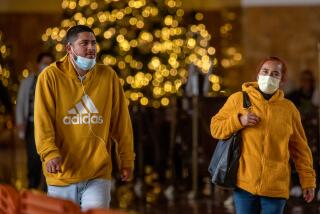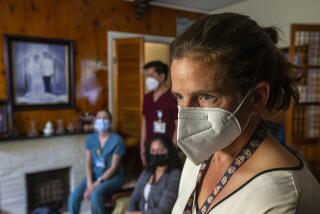Latest coronavirus numbers give San Diego a chance of avoiding the most restrictive tier

- Share via
SAN DIEGO — Though the full picture will not be clear until Tuesday, it appears that San Diego County has a good chance of staying at its current tier in the state’s coronavirus reopening system, preventing a change in restrictions that would require many organizations to stop operating indoors.
Case totals by episode date posted by the county health department Sunday night have the region’s average daily case rate at 6.8 from Sept. 6 through Sept. 12, the measurement window that the California Department of Public Health will use to build its weekly report for release midday Tuesday.
That’s slightly under the limit of 7 cases per 100,000 residents that would cause the county to fall to the lowest and most restrictive tier — color-coded purple — in the state’s four-level COVID-19 risk ranking system.
It is, however, impossible for the general public to fully calculate every facet of that upcoming report. The state adjusts raw case rates based on whether each county’s number of tests per capita was higher or lower than the state average, decreasing scores for areas with more robust testing and increasing them in areas performing fewer tests on average.
San Diego County was negatively affected by this adjustment system last week, seeing its raw case rate of 7.9, already over the threshold of 7, increased to 8.1 because its average number of tests per 100,000 residents was 198, under the state average of 216.
The state will use the same seven-day window — Sept. 6 to Sept. 12 — to determine how many tests were performed in each county, and it uses the date that samples were collected from patients, not the dates that test results are reported to health departments, to decide which tests fall into the calculation window.
Because neither the state nor the county publicly report the number of daily specimens collected, it is difficult for the public to determine whether San Diego County might see its raw case rate adjusted up or down.
It is, however, clear to see that there is a positive trend on the testing front. The county health department does publish the total number of test results received daily, and that number was consistently more robust over the past week.
The Sunday-to-Sunday average number of test results returned was 8,374 for the week just ended compared to 6,401 for the same period two weeks ago.
There is one more caveat that affects the region’s tier level: the positive test rate. Defined as the percentage of positive tests among all tests conducted for the same seven-day window, counties can end up in the purple tier if their positive rate exceeds 8%.
So far, the county’s positive test rates have been well within guidelines, coming in at an average of 4.5%, a number low enough to qualify for the next least-restrictive tier if not for the region’s case rate heading in the opposite direction.
It only takes one number being out-of-bounds for two weeks for a county to fall a tier, but both numbers have to meet higher tier requirements for two consecutive weeks in order to move up a rung on the reopening ladder. Like the case rate adjustments, positive rate calculations use testing numbers by sample collection date, meaning that the public does not have access to the data needed to determine what the positive rate is likely to be in Tuesday’s report.
Sisson writes for the San Diego Union-Tribune.
More to Read
Sign up for Essential California
The most important California stories and recommendations in your inbox every morning.
You may occasionally receive promotional content from the Los Angeles Times.











